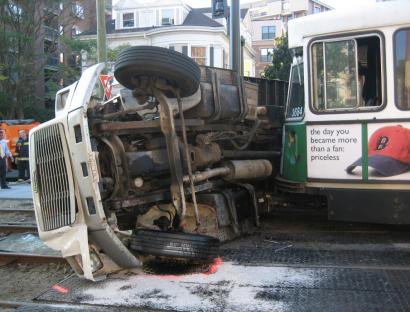Ok, seriously guys, can we have a chat?
Why on Earth do we keep talking about a rapid transit extension through a low-density area which couldn't even support commuter rail? Out of all the viable rapid transit extensions, I feel not a single one is ever talked about more on this forum than a Red Line North extension. Red to Waltham is more viable than that. The horse's decomposed remains have been beat into dust, and the dust was beat until it dispersed and blew away in the breeze. And then it was beat some more.
Per the most recent estimates (2003 PMT) they crunched +6700 daily weekday riders on the Red Line and +1700 daily weekday riders not currently taking any form of transit. That's not chopped liver, and either extreme--"WE NEED THIS NOW!" or "IT'S A DEAD HORSE!"--is a bunch of shrill histrionics.
It's low-rated overall because it's the most end-to-end miles of any rapid transit extension and the capital cost per rider is going to be a bitch because of the mileage. And you need to have a winning development strategy for Hanscom before before dragging it all the way out there. That doesn't exist today. The talk about Boston needing a second airport is premature, and it's a long ways away from being an employment anchor. But that's why you frame this as TWO separate extensions: Heights, and Hanscom. Nobody treats Blue to Salem as a monolithic build out of Wonderland despite the new transit ridership and cost-per-rider on the stations past Lynn being
better than to Lynn. For simple fact that Lynn has other pressing needs, and one foot has to go before the other. This one shouldn't be treated that way either. That's just its legacy because it happened to be the last thing formally studied in an era that couldn't be more different than today.
It's 1.5 miles of shallow box tunneling that restores the Minuteman to as-is condition, and 1 subway stop. That's non-controversial and a non-backbreaker. It's 1.5 miles of preferably surface routing with shifted trail, less-preferably a combo of some surface and some cover-over around abutters. At a third the total distance to Hanscom and only 2 of the 5 stations specced for an extension to Hanscom, Height's per-rider capital and operating costs more or less hit the league average for the much better-hyped Orange/Blue extension proposals. So don't be absolutist and lump the two builds together, and don't treat it as off-scale with similar extensions. It's not off-scale.
Demand for Heights has been established since 1945, is growing acute with Mass Ave. congestion, will grow more acute when GLX gets to Route 16 and generates still more rapid transit demand in Arlington...and they have some degree of non-buyer's remorse about turning this down in the 70's when it was there for the taking at more favorable cost. You can't blithely assume the 1.5 miles miles past the High School will be nuked from orbit without attempting to negotiate. So neither be absolutist nor lump it in with Hanscom, which is a future-not-present tense growth prospect.
Lex isn't ready for it. Hanscom definitely isn't ready for it without some sort of compelling master plan. We don't know if either will ever be ready for it. We also don't know how Lexington would utilize it, since Alewife is 6 miles away from Lexington Center and virtually unreachable because of congestion and multiple required bus transfers while Heights would be a fast transfer. You also can't assume the first leg doesn't serve and draw Lexington ridership. So don't be absolutist.
OK? That's not unrealistic. Whether you would rank it in your Top 5 system expansion priorities is up for debate, but hyperbole...no. That's as useless at either extreme.
So is comparing it to commuter rail that ran one round trip per day in 1977 on equipment so shot it had with par odds of not making it to destination...run by an operator in its 7th year of bankruptcy reorganization. It is a bunk, hysterical comparison.
And Red to Waltham as icing-on-cake for a hyperbolic statement about Arlington/Lexington is equally useless. You can't physically get out of Alewife in that direction without blowing up the Pfizer campus, and you probably can't eliminate the Waltham Ctr. grade crossings with the bridges immediately east constraining the incline room and the Charles 100 ft. away most definitely making a cut no-go. LRT out of Union/Porter is probably the only extensible mode out there. That's a whole separate argument, but using that as the basis for a hyperbole indictment of Red extensions is likewise...a bunk, hysterical comparison. Waltham has absolutely zilch to do with a Red extension.




